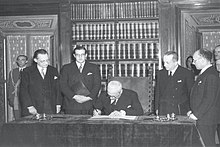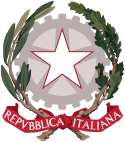
Back دستور إيطاليا Arabic Constitución de la República Italiana AST Конституция на Италия Bulgarian Constitució d'Itàlia Catalan Verfassung der Italienischen Republik German Σύνταγμα της Ιταλίας Greek Konstitucio de la Itala Respubliko Esperanto Constitución de la República Italiana Spanish قانون اساسی ایتالیا Persian Constitution de la République italienne French
| Constitution of the Italian Republic | |
|---|---|
 The provisional head of state, Enrico De Nicola, signing the Constitution by virtue of Provision XVIII, on 27 December 1947 | |
| Overview | |
| Original title | Costituzione della Repubblica Italiana |
| Jurisdiction | Italy |
| Ratified | 22 December 1947 |
| Date effective | 1 January 1948 |
| System | Unitary parliamentary constitutional republic |
| Government structure | |
| Branches | Three: Legislative, Executive, Judicial[a] |
| Head of state | President of the Republic, elected by an electoral college |
| Chambers | Two: Chamber of Deputies and Senate of the Republic |
| Executive | Council of Ministers, headed by a President of the Council |
| Judiciary | Constitutional Court, Supreme Court of Cassation, Court of Audit and Council of State |
| Federalism | No, but constituent entities enjoy self-government |
| Electoral college | Yes: consists of Parliament and three delegates of Regional Councils[b] |
| Entrenchments | 1 |
| History | |
| Amendments | 16 |
| Last amended | 2022 |
| Full text | |
| Part of the Politics series |
 |
|---|
|
|
The Constitution of the Italian Republic (Italian: Costituzione della Repubblica Italiana) was ratified on 22 December 1947 by the Constituent Assembly, with 453 votes in favour and 62 against, before coming into force on 1 January 1948, one century after the previous Constitution of the Kingdom of Italy had been enacted.[1] The text, which has since been amended sixteen times,[2] was promulgated in an extraordinary edition of Gazzetta Ufficiale on 27 December 1947.[3]
The Constituent Assembly was elected by universal suffrage on 2 June 1946, on the same day as the referendum on the abolition of the monarchy was held, and it was formed by the representatives of all the anti-fascist forces that contributed to the defeat of Nazi and Fascist forces during the Italian Civil War.[4] The election was held in all Italian provinces, except the provinces of Bolzano, Gorizia, Trieste, Pola, Fiume and Zara, located in territories not administered by the Italian government but by the Allied authorities, which were still under occupation pending a final settlement of the status of the territories (in fact in 1947 most of these territories were then annexed by Yugoslavia after the Paris peace treaties of 1947, such as most of the Julian March and the Dalmatian city of Zara).[5]
Cite error: There are <ref group=lower-alpha> tags or {{efn}} templates on this page, but the references will not show without a {{reflist|group=lower-alpha}} template or {{notelist}} template (see the help page).
- ^ Einaudi, Mario (August 1948). "The Constitution of the Italian Republic". American Political Science Review. 42 (4): 661–676. doi:10.2307/1950923. JSTOR 1950923. S2CID 145689252.
- ^ "Referendum, ecco le 16 volte in cui la Costituzione è stata cambiata" (in Italian). Retrieved 25 October 2023.
- ^ "Costituzione della Repubblica Italiana". www.gazzettaufficiale.it. Gazzetta Ufficiale. Archived from the original on 14 November 2019. Retrieved 14 November 2019.
- ^ McGaw Smyth, Howard (1948). "Italy: From Fascism to the Republic (1943-1946)". The Western Political Quarterly. 1 (3): 205–222. doi:10.2307/442274. JSTOR 442274.
- ^ Sapori, Julien (14 August 2009). "Les «foibe», une tragédie européenne". Libération (in French).[permanent dead link]